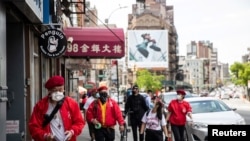Since mid-March, a U.S.-based coalition has tracked more than 2,100 anti-Asian hate incidents, a troubling figure that Asian American advocates say is being fueled in part by political rhetoric against China during the coronavirus pandemic.
While racial slurs and other forms of verbal harassment constituted the vast majority of the incidents, nearly eight percent involved physical assaults, businesses barring Asian Americans from entering their establishments due to misplaced coronavirus fears, and attackers coughing and spitting on victims, according to STOP AAPI Hate, an anti-Asian hate tracker.
In one incident in March, a group of African American teenagers on a commuter rail in San Francisco used their backpacks to attack a mask-wearing Asian American, saying he had COVID-19, the disease caused by the coronavirus.
In another occurrence in April, a stranger threw a large rock through the atrium window of a Chinese American family’s house in Santa Rosa, California. The house had Chinese writing along the front door as a blessing for good health and harmony.
“These are first-hand accounts where individuals are describing harrowing and traumatizing experiences, including what is being said to them when they’re being attacked,” said Cynthia Choi, co-executive director of Chinese for Affirmative Action, one of the coalition partners.
Asian Americans have been targeted before during public health crises, as was the case during the 2003 SARS epidemic. The latest wave of anti-Asian hate comes at a time of heightened tensions over the pandemic fueled by the anti-China rhetoric of President Donald Trump and other politicians. Trump, who initially praised China for its handling of the crisis, subsequently blamed China’s leader Xi Jinping for waiting weeks to report the outbreak in Wuhan to the World Health Organization and covering up the severity of the problem.
Trump has repeatedly referred to the coronavirus as the “Chinese virus” and “kung-flu,” terms that Asian American advocates say are derogatory and have exacerbated the scapegoating of Americans of Asian descent.
Trump disputes that those and other terms are racist. White House counselor Kellyanne Conway, who several weeks ago criticized the phrase kung-flu as “highly offensive,” and press secretary Kayleigh McEnany both said this week that the president used the term merely to highlight that the virus originated in China.
But Asian American leaders say the meaning is not lost on their fast-growing community.
“Those are terms meant to be humiliating,” said Gene Wu, a Chinese American Democratic member of the Texas House of Representatives.
Phil Ting, a Democratic state assemblyman in California, said the rhetoric has had a direct impact on the surge in anti-Asian harassment and hate crimes.
“You see leaders express words that really give license to other people to express those same sentiments and also to act on them,” Ting said.
In a recent report examining the link between political rhetoric and anti-Asian bias, STOP AAPI Hate, the Asian American coalition, found that reports of anti-Asian discrimination spiked after Trump repeatedly used the term “Chinese virus.”
While the vast majority of the 2,100-plus incidents recorded by STOP AAPI Hate do not rise to the level of a hate crime as defined by statute, more than 100 do, according to legal experts.
This surge in anti-Asian hate crime comes at a time when most American cities are reporting an overall decline in other categories of bias attacks, according to Brian Levin, director of the Center for the Study of Hate and Extremism at the California State University.
The FBI defines a hate crime as a criminal offense motivated by bias against the victim’s race, religion, disability, sexual orientation, ethnicity, gender, or gender identity
California, home to the nation’s largest Asian American population, has been particularly hard hit. In Los Angeles, police recorded 10 anti-Asian hate crimes through April 30, compared to a total of four for all of 2019, according to police data compiled by the Center for the Study of Hate and Extremism.
In San Francisco, there were five anti-Asian hate crimes through March 31, compared to six for all of last year, according to police data.
Other major cities have reported far fewer cases of anti-Asian hate crimes. In New York City, police recorded just two incidents through May 17, compared with three for last year. In addition, there were 20 coronavirus-related hate crimes. In April, an Asian American woman in Brooklyn, New York, suffered second-degree burns after a man poured acid on her.
One of the most horrific anti-Asian hate crimes came in March when a teenager stabbed an Asian American man and his two young children at a supermarket in Midland, Texas. The suspect reportedly carried out the attack “because he thought the family was Chinese and infecting people with the coronavirus.”
“In the cities where anti-Asian hate crimes increased, they increased significantly to the extent that there were almost as much anti-Asian hate crime as we had for all of last year or significantly more,” Levin said.
The surge in the crimes has not been limited to the U.S. From Melbourne, Australia, to Vancouver, Canada, Asian American communities have reported a surge in discrimination, harassment and assault.
In Vancouver, billed as the “most Asian city outside Asia,” there were 20 anti-Asian hate crimes through April 29, up from 12 for all of last year. London, another major city with a large Asian population, had 267 anti-Asian attacks, compared with 375 for all of last year.
“This is a global pandemic of hate,” said Helen Zia, a prominent Chinese American civil rights activist and author.








